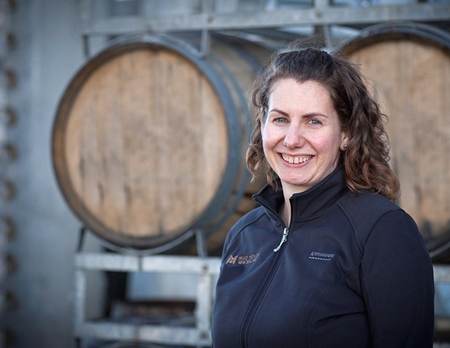Did you know that there are about 5,000 different grape varieties that are capable of making wine? No, I thought not. Though to be honest, most of the world’s wine comes from just a couple of dozen well-known grape varieties. But you know, the variations possible among a single grape variety are quite amazing.
Taste a Chenin Blanc from the Loire region of France and then one from California and you’ll swear you are drinking a completely different wine. The Rieslings of the Mosel Valley and those of Australia are poles apart. And you don’t need to compare wines from the opposite sides of the world. In Burgundy, a Pinot Noir can taste quite different from another one from just down the road.
 Nadine Worley: Winemaker at Mud House
Nadine Worley: Winemaker at Mud House
So why is this? Well, part of the reason for this variation is known as “terroir”. It’s a French word because the French invented it. They could have saved us a lot of bother by choosing an English word, but of course being French, they didn’t. To be fair though, there isn’t a single word in English that means quite the same thing. In a very tiny nutshell, “terroir” means everything to do with the geography, geology, topography and climate that influence the growth of a vine. Sometimes there are different terroirs within a single vineyard. Apart from all this, the visions and skills of the grape-growers and the winemakers have a significant impact. Yet strangely, some of the enigmatic biochemical processes that occur between virgin grape juice and the finished wine are still not fully understood.
These two New Zealand wines are imported by Siam Winery and like the other Mud House wines I mentioned recently, are not yet available at retail outlets. However, you can evidently buy them at the Amari Orchid Hotel’s Mantra Restaurant. With the usual restaurant mark-up on wines, expect to pay around Bt 1,500++ per bottle.
Mud House Marlborough Sauvignon Blanc 2011 (white), New Zealand
The best Sauvignon Blanc (SOH-vee-nyon BLAHN) wines come from France and New Zealand, but this wine tastes refreshingly different to its distant French cousins. It’s a delicate, pale straw colour with a tantalising and rather unexpected aroma. The vibrant aroma is fresh, fruity, cool and invigorating with reminders of gooseberries, grapefruit, dill and passion fruit. You’ll probably also pick up the Sauvignon trademark of wild grassy aromas, herbs and nettles. On the palate there’s an almost multi-dimensional flavour: bold, very dry and sharply-focused. With plenty of fresh fruit, the wine is balanced by a zesty tang of grapefruit-like acidity. It’s medium-bodied with a satisfying, dry finish and at 13% alcohol content, it would match brightly flavoured seafood and fish dishes. It would work well with many Thai and Asian dishes too.
This must be one of the finest Sauvignons that I have tasted recently. I am not surprised that in 2011 it won a Gold Medal at the UK International Wine and Spirits Competition. Wine maker Nadine Worley has not only tamed the feisty Lady of the Loire by bringing out her sunnier qualities, but also preserved the essential crisp and fresh character of the grape. Now I’m not a winemaker, but I reckon that takes some doing. And it seems so do a lot of other people, for Nadine has already acquired many international trophies and received critical acclaim from around the world.
Mud House Central Otago Pinot Noir 2011 (red), New Zealand
If, for some surreal reason, I was forced to live with red wine from one grape variety and nothing else, it would be Pinot Noir. Cabernet Sauvignon would probably be Number Two but Pinot would top the list. It hails from Burgundy of course, where it makes some of the finest red wines in the world, invariably at breath-taking prices. This splendid wine has taken on a new dimension to traditional Burgundy and in terms of flavour, texture and depth it actually seems closer to a Shiraz.
It has an alluring fruity aroma that wafts out as soon as you pour it into the decanter. There are reminders of jammy red cherries, a touch of warm spice and plums, hints of oak and you might just detect a seductive hint of rose petals. The wine has a very soft texture with loads of rich fruit on the palate including cherry, red currant and a dash of herbs and roses in the background. There’s also a lively sharpness and a fine cut of acidity that balances out the fruit. This clean-tasting, supple wine has soft tannins and an oaky, persistent fruity finish. At 14% alcohol content this is pretty well at the top of the tree for table wines. It would make an excellent partner for roast beef, roast lamb or even roast duck.
About a third of the wine was aged in French oak barrels, to bring out the oaky quality while the rest of it was matured in stainless steel tanks, to preserve the bright fruit flavours. I mention this fact just as a reminder that it’s not only terroir that brings about variations in wine, but also a great deal of human intervention. Grape juice – left to its own devices – would simply turn into vinegar.




